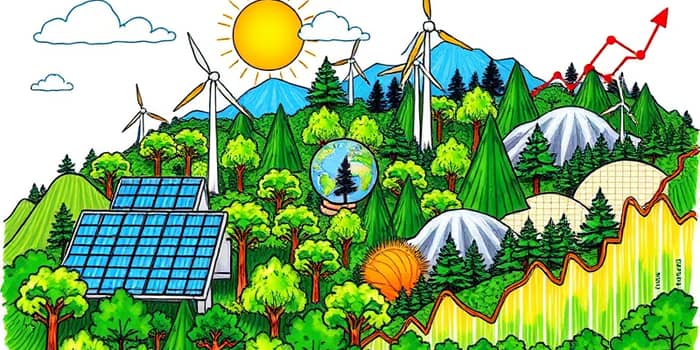The sustainable investment landscape has entered a new era, driven by a potent mix of capital flows, policy shifts, and investor expectations. In 2024, global sustainable fund assets surpassed $3 trillion, and forecasts point to a surge toward $34 trillion by 2026. This article explores the forces behind this expansion, highlights dominant strategies, and outlines the path ahead.
Market Size and Future Trajectory
Investor interest is surging as 73% of market participants predict unprecedented investor demand and growth in the next one to two years. Regulatory support, client pressure, and performance data are combining to fuel robust growth prospects and outlook.
In 2024 alone, issuance of sustainable bonds and loans reached $1.5 trillion globally, while 79% of US assets—equivalent to $41.5 trillion—now fall under stewardship policies aligned with environmental, social, and governance criteria. These figures underscore the scale of capital reallocation toward sustainable objectives.
Dominant Strategies and Investment Products
Asset managers employ a range of approaches to meet sustainability goals. Two methods dominate:
- ESG integration and exclusionary screening: 81% of investors integrate environmental, social, and governance factors into financial analysis, while 75% apply negative screens, with fossil fuel exclusions leading at 68%.
- Impact and sustainability themes: 36% of participants prioritize funds explicitly targeting social and environmental outcomes, from clean energy to affordable housing.
Alternative investments in private equity and thematic bonds are outpacing public markets, achieving a 17% compound annual growth rate over five years versus 11.9% for public equities. This has driven a 123% cumulative expansion in low-carbon private market funding since 2019.
Thematic Drivers and Emerging Focus Areas
Several themes dominate investment agendas in 2025:
- focus on climate and clean energy: Solar PV, electric vehicles, and carbon reduction technologies command the highest allocations.
- Alignment with UN Sustainable Development Goals, especially SDG 13 (Climate Action) and SDG 7 (Affordable Clean Energy).
- Rising interest in biodiversity finance, with nature-positive solutions gaining momentum.
Investors are also exploring innovative tools such as biodiversity credits and blue bonds, marking a shift from purely carbon-centric strategies to broader ecological considerations.
Regulatory and Policy Landscape
The next phase of sustainable finance will be shaped by an evolving global policy frameworks. In the EU, the Sustainable Finance Disclosure Regulation (SFDR) now covers roughly 60% of regional funds under Articles 8 and 9. 2025 is widely regarded as a “testing year” for European ESG mandates, with scrutiny intensifying on reporting quality and impact claims.
Meanwhile, the US grapples with political headwinds, as debates over anti-ESG legislation and potential rollbacks create uncertainty. Despite this, government subsidies and trade policies for clean energy have strengthened since 2020, offering a supportive backdrop for investors.
Technology and Data Innovation
Advances in artificial intelligence and data analytics are transforming how portfolios are constructed and monitored. Sixty-five percent of market observers identify AI as a key trend, enabling firms to deploy sophisticated data analytics platforms that measure performance and risk at unprecedented granularity.
However, AI’s rising energy demand and environmental footprint pose a paradox: technologies that drive efficiency can also introduce new sustainability challenges. Robust data governance and transparent methodologies are becoming critical to maintain trust and accuracy in ESG reporting.
Performance, Risks, and Market Challenges
In 2024, multiple sustainable indices delivered superior returns compared to traditional benchmarks, highlighting the outperformance of sustainable indices. Yet, investors must navigate macroeconomic volatility, fluctuating interest rates, and geopolitical tensions that can impact green asset valuations.
Greenwashing remains a pressing concern. Calls for enhanced disclosure standards and regulatory harmonization are growing louder as stakeholders seek to differentiate authentic impact strategies from superficial claims.
Subsector Highlights
Key sub-sectors to watch include:
- Renewables: Solar and wind capacity is projected to eclipse coal by 2025 in several regions.
- Sustainable Bonds: Lower interest rates are expected to spur further issuances.
- Nature-Based Finance: nature-based financing and biodiversity mechanisms are unlocking new capital for ecosystem restoration.
Outlook and Call to Action
As we look toward 2026 and beyond, the sustainable investment market is poised to redefine global capital flows. Stakeholders must embrace agility in product design, strengthen data integrity, and champion transparency to build lasting trust.
By leveraging innovation, policy engagement, and rigorous stewardship, investors can embrace sustainable investment strategies that deliver both financial returns and positive environmental impact. The time to act is now, as the choices made today will shape the resilient, equitable, and low-carbon economies of tomorrow.
References
- https://www.ussif.org/research/trends-reports/us-sustainable-investing-trends-2024-2025-executive-summary
- https://www.lseg.com/en/insights/ftse-russell/expect-continued-evolution-in-the-sustainable-investment-market
- https://www.morningstar.com/sustainable-investing/public-policy-drives-sustainable-investing-markets-2025
- https://www.spglobal.com/esg/insights/2025-esg-trends
- https://connect.sustainalytics.com/six-sustainable-investing-trends-to-watch-in-2025-report
- https://sustainabilitymag.com/top10/top-10-trends-in-sustainable-finance-for-2025
- https://www2.deloitte.com/us/en/insights/industry/financial-services/esg-investing-and-sustainability.html
- https://www.msci.com/www/blog-posts/what-could-shape-sustainability/05266596954










